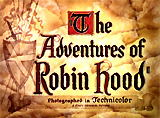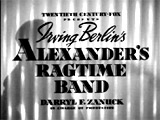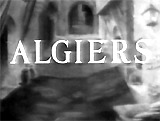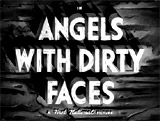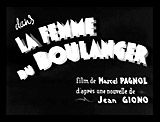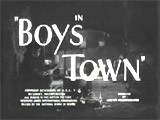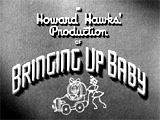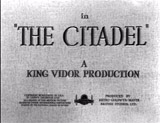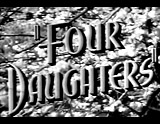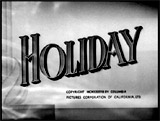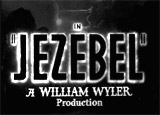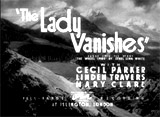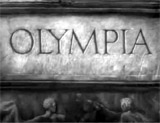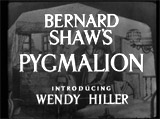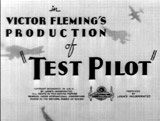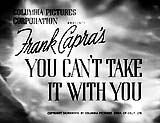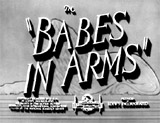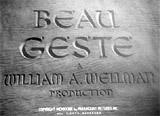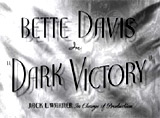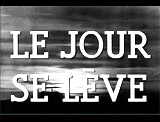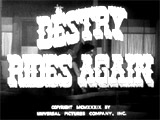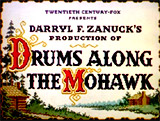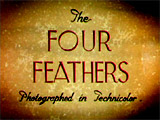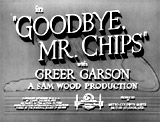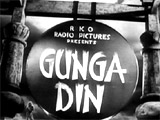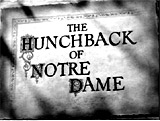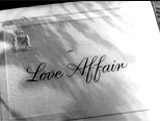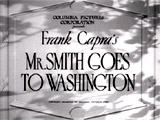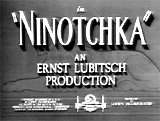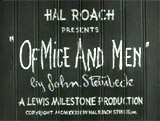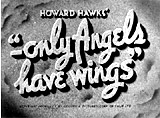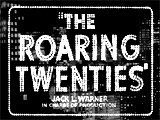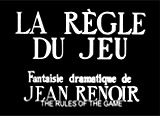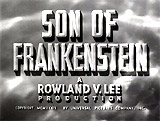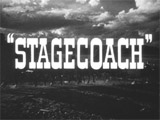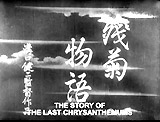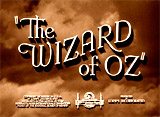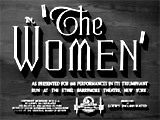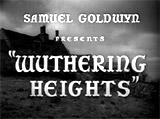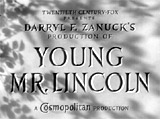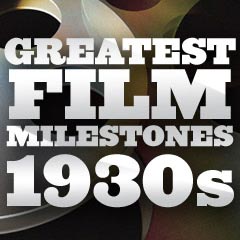 | Milestones and Turning Points in Film History The Year 1938 |
![]()
(by decade and year) Introduction | Pre-1900s | 1900s | 1910s | 1920s | 1930s | 1940s | 1950s 1960s | 1970s | 1980s | 1990s | 2000s | 2010s | 2020s |
| Event and Significance | |
| For the first time, a group of movie stars organized a committee, the Motion Picture Democratic Committee, to support a political party. | |
| During the filming of The Wizard of Oz (1939), Buddy Ebsen (as the Tin Woodsman character) was hospitalized due to an allergic reaction to the aluminum dust required for his costume. He was replaced by Jack Haley for the immortal role. | |
| Producer Jed Buell's B-western/musical The Terror of Tiny Town (1938) (with the tagline: "Little Guys with Big Guns") was the first film with an "all-midget" cast, portraying cowboys and cowgirls. The amusing "novelty" cult film flopped miserably, and has been rated as one of the worst films ever made. | |
| African-American leaders publically called on the Hays Office to make roles other than doormen, maids, and porters available to blacks. | |
| The first appearance of an early prototype of Bugs Bunny, possibly the greatest cartoon character of all-time, was as Porky Pig's antagonist in Warners' Porky's Hare Hunt (1938). He would appear fully-developed and in his first starring role in Tex Avery's Oscar-nominated A Wild Hare (1940). | |
| Action Comics No. 1 was published in June of 1938, marking the debut of the comic book character Superman. Superman's first film appearance came a few years later - he debuted in an animated series of seventeen Superman cartoons, beginning with Fleischer Studios' creations from 1941-1942, in an agreement with DC Comics. Dave and Max Fleischer were responsible for the first nine Superman cartoons (the pilot and eight subsequent shorts). | |
| All the major movie studios (the Big Five) were sued in 1938 by the U.S. Department of Justice in the government's anti-trust lawsuit against unfair trade practices, claiming that the studios monopolized both the production and distribution of motion pictures. Eventually, the case reached the US Supreme Court 10 years later, in a decision against the movie studios. | |
| Versatile director Howard Hawks' greatest screwball comedy, Bringing Up Baby (1938), opened - it has often been considered the definitive screwball film and one of the funniest, wackiest and most inspired films of all time. However, at the time of its release, it failed miserably at the box-office after two weeks in the theaters, and was soon forgotten, until it was revived years later. The film was Katharine Hepburn's only screwball comedy role, and her final film for RKO, since she had been infamously labeled 'box-office poison' through most of the 1930s. | |
| The first and only on-screen kiss between the memorable dancing-singing partnership of Fred Astaire and Ginger Rogers was in their 8th RKO film, Carefree (1938). | |
| Director and narrator Orson Welles' 60 minute adaptation of the H.G. Wells' novel The War of the Worlds was broadcast on the CBS Radio Network on October 30, 1938. The show was performed for Welles' radio drama anthology series Mercury Theatre on the Air. Its airing caused panic in various parts of the US when listeners believed a real Martian alien invasion was occurring. The event also brought Orson Welles publicity and notoriety, allowing him to become a film-maker with his first feature film, Citizen Kane (1941). | |
| Roy Rogers made his starring film debut in the Republic Studios' B-western Under Western Stars (1938), after which he became popularly known as the "King of the Cowboys" replacing Gene Autry. Singing cowboy Roy's song in the film, Dust, was nominated as Best Original Song (written by Johnny Marvin), but the Academy Award went to Thanks for the Memory in The Big Broadcast of 1938 (1938). | |
| A series of 28 films over a period of 12 years, based on Chic Young's popular comic strip Blondie, made its debut with the first film Blondie (1938). The situation-comedy films starred Penny Singleton as Blondie Bumstead and Arthur Lake as bumbling husband Dagwood, plus their five year-old son Alexander (aka Baby Dumpling) (Larry Simms). The last film in the series was Blondie's Hero (1950). The three major directors of the films included Frank Strayer, Abby Berlin, and Edward Bernds. | |
| Russian director Sergei Eisenstein directed the epic film Alexander Nevsky (aka Aleksandr Nevskiy, Russ.), a nationalistic film that presented the medieval story of the 13th century Russian prince Alexander Nevsky (Nikolai Cherkasov) -- enhanced with a score by Sergei Prokofiev. The film's most memorable battle scene was on the ice (that started to crack) at frozen Lake Peipus in 1242 between the invading barbaric Teutonic knights and the Russian army - both wielding spears and axes. | |
| MGM loaned actor Clark Gable to David O. Selznick for his production of Gone With the Wind (1939) for his most famous role as Rhett Butler, in exchange for the film's distribution rights and one-half of the profits (further reduced by Loew's Inc.'s 15% interest and a requirement to pay Gable's $4,500 per week salary and one-third of Gable's $50,000 loan-out bonus). | |
| Innovative and pioneering French filmmaker Georges Melies died at the age of 76 in Paris, France. He was noted for the use of magical special effects in his early films, including the stop-trick (or substitution) effect used to make things seemingly disappear. His most famous film was Le Voyage Dans La Lune (1902) (aka A Trip to the Moon). | |
| Spencer Tracy won his second Best Actor Oscar in early 1939. He had won the 1937 Oscar for his role as Portuguese fisherman Manuel in Captains Courageous and then this 1938 award for Boys Town. This was the first time that an actor had won the Oscar in consecutive years. |
| Event and Significance | |
| This year has often been called the "greatest year in film history" by film buffs, movie historians, and critics, chiefly due to the inordinate number of classic films. Some of the greatest films ever made were released in 1939, including Gone With the Wind, The Hunchback of Notre Dame, Mr. Smith Goes to Washington, Ninotchka, Stagecoach, The Wizard of Oz and Wuthering Heights. In France, both Marcel Carné's Daybreak (aka Le Jour Se Lève) and Jean Renoir's The Rules of the Game (considered by some to be the greatest film of all-time, but banned during the German occupation) were released. Other major classic films in 1939 included Beau Geste, Dark Victory, Destry Rides Again, Love Affair (later remade as An Affair to Remember), Only Angels Have Wings, Gunga Din, Midnight, Of Mice and Men, The Women, Young Mr. Lincoln, and many more. | |
| Gone With the Wind (1939), directed by Victor Fleming and starring Clark Gable and Vivien Leigh, was world-premiered in racially-segregated Atlanta, Georgia. It was exactly 75 years after General Sherman had set the city on fire in 1864 during the Civil War. This big-screen adaptation of Margaret Mitchell's best-selling novel was a 228-minute Civil War epic drama that went on to profitably gross almost $200 million (domestic). With a production cost of over $4 million - it was the longest and most expensive Hollywood sound film of the time. It also remains the domestic box-office champ with a gross of $1.67 billion (adjusted for inflation). Its casting call for the lead female role of Scarlett O'Hara ended up being one of the biggest ever with multiple actresses being considered for the highly desired role, ending when little-known British actress Vivien Leigh signed on for the role. It was nominated for thirteen Oscars, and won eight competitive statues (including Best Picture) - a record for its time, and two special awards in the awards ceremony in early 1940. It was the first color film to win Best Picture. Best Supporting Actress Hattie McDaniel became the first African-American performer to win an Oscar, Best Supporting Actress (she was also the first African-American nominee for an Oscar, and the first African-American guest at the awards ceremony). However, McDaniel and other black cast members couldn't attend the film's premiere in mid-December 1939 in Atlanta. | |
| Of the ten films nominated for the Best Picture Oscar in 1939, actor Thomas Mitchell starred in three of them - a record: Gone with the Wind (1939) as Gerald O'Hara, Mr. Smith Goes to Washington (1939) as Diz Moore, and Stagecoach (1939) as Dr. Josiah Boone. In the single year, he had roles in three films nominated for Best Picture. (He won for his nominated supporting role in Stagecoach (1939).) This same feat occurred for John C. Reilly in five films nominated for the Best Picture Oscar in 2002. | |
| MGM’s classic musical The Wizard of Oz (1939) starring Judy Garland as Dorothy, premiered in Hollywood at Grauman’s Chinese Theatre on August 15, 1939. | |
| John Ford's classic frontier western Stagecoach (1939) was the first film that the director shot in Utah's Monument Valley -- the site would repeatedly be used as the locale for most of his other Westerns. The film marked the breakthrough, star-making role for B-western actor John Wayne, as Ringo Kid. | |
| Swedish actress Ingrid Bergman made her American film debut (and English-speaking debut) as piano teacher/concert pianist Anita Hoffman in Intermezzo: A Love Story (1939). She starred opposite Leslie Howard (as world-famous violinist Holger Brandt). It was a remake of the Swedish version of the same film made two years earlier as Intermezzo (1936) (and released in the US in 1937). | |
| Dashing, athletic silent film movie star Douglas Fairbanks, Sr. ("The King of Hollywood"), the husband of Mary Pickford, and known for his swashbuckling roles (The Mark of Zorro (1920), Robin Hood (1922), and The Thief of Bagdad (1924)) and for his co-founding of United Artists, died of a heart attack at the age of 56. | |
| British actor Basil Rathbone, as Sherlock Holmes - with an Inverness cape and curved-stem pipe, was accompanied by dull-witted, pipe-smoking Nigel Bruce as Dr. Watson, in their first appearance together as the crime-fighting duo, in 20th Century Fox's The Hound of the Baskervilles (1939). It was the first of 14 screen pairings for the actors from 1939 to 1946. In the same year, they also starred in Fox's The Adventures of Sherlock Holmes (1939). Their next twelve Sherlock Holmes films were made for Universal. | |
| The California Child Actor's Bill, better known as the Coogan Law was enacted. The child labor reform act took place after 24 year old Jackie Coogan, who had starred in The Kid (1921) opposite Charlie Chaplin, sued his parents (mother and stepfather) in 1938 for mismanaging and exploiting his career and spending his acquired fortune as a young star. In August 1939, Coogan and his mother reached a settlement in which he received about half of the remaining funds (totaling $252,000), or $126,000. To protect the earnings of child actors, the Coogan Law required that 15% of a child's earnings be set aside in a trust that could not be tapped without a court order until the child came of age. Various child labor laws and other similar acts have since been established. Later, Coogan became known for playing Uncle Fester on The Addams Family television show. | |
| Director George Cukor filmed the 1937 Broadway hit as The Women (1939), based upon Claire Booth Luce's play. It was notable for having an all-female cast, featuring all of the female stars at MGM (except for Myrna Loy and Greta Garbo). | |
| With his supporting roles in Frank Capra's You Can't Take It With You (1938) as Donald and Gone With the Wind (1939) as Uncle Peter, Eddie "Rochester" Anderson became the first black performer to appear in more than one Oscar-winning Best Picture. This led to his top billing in the MGM musical Cabin in the Sky (1943). | |
| The future rival to film -- television -- was formally introduced at the New York World's Fair in Queens. The Radio Corporation of America (RCA) unveiled a display of its first TV sets for sale to the American public. | |
| Detective Comics introduced the character of super-hero Batman in issue No. 27, released in March of 1939. Batman was the first DC Comics character to have his own serial, Columbia Pictures' 15-episode serial Batman (1943). | |
| The first of four 'backyard' musicals, directed by Busby Berkeley and starring young Judy Garland and Mickey Rooney opened - Babes in Arms (1939). Its success spawned three other similar films: Strike Up the Band (1940), Babes on Broadway (1941), and Girl Crazy (1943). | |
| Mercury Theater stage company founder and CBS radio drama series originator Orson Welles - after his momentous radio adaptation of H.G. Wells' The War of the Worlds on Halloween night 1938 - signed an unprecedented contract with RKO Pictures in 1939. It was a two-year, two-picture contract as producer-director-writer-actor, in which Welles reserved complete control over all aspects of two productions of his own choosing, including "final cut," as long as he remained within the studio-approved schedule and budget. Although resented by many in Hollywood, it led to more individual control by talented filmmaking individuals, and to Welles' considerable artistic control over his production of Citizen Kane (1941). | |
| Two of the greatest Hollywood-related gossip columnist rivals competing for readership in the late 1930s were Hedda Hopper and Louella Parsons, who worked for William Randolph Hearst's syndicated newspaper chain. The Hopper column made its debut in early 1938 in 13 newspapers, including the Los Angeles Times. Her first startling, scandal-tinged article, published in October of 1939, scooped Parsons on the impending divorce of James Roosevelt, eldest son of President Franklin Delano Roosevelt. He had left the government as an aide to his father in 1938, and went to Hollywood to work in the movie business as an aide to Samuel Goldwyn. Roosevelt's first marriage to Betsey Cushing eventually ended in divorce in 1940. The two "Queens of Celebrity Gossip" helped to fuel an industry of celebrity-gossip that exists to this day. | |
| The eight largest US film studios raked in 90% of US film profits at the end of the 1930s. |
1938
Title Screen Film Genre(s), Title, Year, (Country), Length, Director, Description


The Adventures of Robin Hood (1938), 106 minutes, D: Michael Curtiz, William Keighley
One of the best of Hollywood's swashbuckler adventure films, and one of star Errol Flynn's best portrayals. With many remakes too numerous to mention - and mostly inferior. This was the most expensive Warner Bros. film to date at $2 million, but it turned out to be the studio's biggest money-maker in 1939. It was the second of eight films to pair Errol Flynn and Olivia de Havilland. The legendary and infamous hero of Sherwood Forest Robin Hood/Sir Robin of Locksley (Errol Flynn), with his 'merrymen', who robs from the rich and gives to the poor. He woos Maid Marian (or Lady Marion Fitzwalter) (Olivia de Havilland) who rides Roy Rogers' future horse Trigger, and confronts his Norman adversaries: evil Prince John (Claude Rains) and his ruthless henchman Sir Guy of Gisbourne (Basil Rathbone), who attempt to take over England and oppress the Saxon masses during King Richard's (Ian Hunter) absence. With beautiful Technicolor sets, pageantry and costumes, dashing sword fighting, music by Oscar-winning Erich Wolfgang Korngold, lively characters, sparkling dialogue, and exciting action.


Alexander's Ragtime Band (1938), 105 minutes, D: Henry King
A nostalgic and lavish 20th Century Fox musical drama (and winner of Best Musical Score) set in the days of vaudeville on Broadway (from 1915-1938), an enjoyable backstage show-biz musical. The fictionalized film followed the career of Alexander/Roger Grant (Tyrone Power), a classical violinist who preferred playing popular ragtime music. He formed a small combo band, and during one gig in San Francisco's Nob Hill, paired up with young contralto singer Stella Kirby (Alice Fay, Fox's studio queen) who sang "Alexander's Ragtime Band" - and afterwards, the band was named Power "Alexander." There were ups and downs in the relationship between the quarreling Roger and Stella, as he intermittently fought for her love over a period of about 25 years and also contended in a love triangle with songwriter Charlie Dwyer (Don Ameche), a romantic rival for Stella. Powerful vocalist Jerry Allen (Ethel Merman) joined the group. This film included 28 Irving Berlin songs, such as "When That Midnight Choo-Choo Leaves for Alabam'," "Everybody's Doing It," "I'm Marching Along with Time," "My Walking Stick," "Heat Wave," and "Now It Can Be Told."

Algiers (1938), 95 minutes, D: John Cromwell
A romantic drama, a story of intrigue and romance. A remake of Pépé le Moko (1937, Fr.) with Jean Gabin, an inspiration for Casablanca (1942), and an inspiration for the musical remake Casbah (1948). [Note: Chuck Jones' and Warners' animated cartoon character "Pepe le Pew" was based on the "Pepe le Moko" character. "Come, let me take you to the Casbah," however, was never spoken in this film. In the cartoon The Cats Bah (1954), Pepe le Pew stated the line: "Come with me to the Casbah," reinforcing the idea that the line was spoken by Boyer in the film.] Crafty international jewel thief Pepe Le Moko (Charles Boyer, in his most famous role) fled to the notorious Casbah district (a safe hiding zone with dark twisting alleyways) in French Algiers to escape from pursuing North African police, led by Inspector Slimane (Joseph Calleia). There, he met and fell into a doomed romance with beautiful, bejewelled, sultry Parisian tourist Gaby (Hedy Lamarr in her American film debut) vacationing with her wealthy businessman fiancée Giraux (Robert Grieg). She was used to tempt Pepe out of the Casbah, where he was fatally shot at the dock.

Angels With Dirty Faces (1938), 97 minutes, D: Michael Curtiz
A superb melodrama starring three greats - Cagney, O'Brien, and Bogart. Two kids from Brooklyn grew up together and followed very different paths in life, one becoming parish priest Father Jerry Connelly (William Tracey as youth, Pat O'Brien as adult), the other big-time, hardened gangster/convict Rocky Sullivan (Frankie Burke as youth, James Cagney as adult). Conflict arose when Rocky returnedd to the neighborhood and was idolized by a group of tough boys (future Dead End kids) who were led by the priest. After Rocky was captured and sentenced to death in the gas chamber after murdering local rivals, Father Jerry asked Rocky for a favor - to die like a coward and not appear as a hero to the boys. With an unforgettable movie moment - as an uncharacteristically-fearful Rocky was led to his execution.

The Baker's Wife (1938, Fr.) (aka La Femme du Boulanger), 133 minutes, D: Marcel Pagnol
A charming comedy/drama, adapted from Jean Giono's novel Jean Le Bleu. In a small Provencal town in the late 19th century, popular new (and rotund) baker Aimable Castanier (Raimu) was married to the beautiful and much younger Aurélie Castanier (Ginette Leclerc), and everyone loved his bread-making. When the unfaithful Aurélie soon ran off with a handsome shepherd named Dominique (Charles Moulin) for a romantic rendezvous, the distraught Aimable stopped baking, became suicidal, and started drinking heavily. The town's three leaders: the Marquis Castan de Venelles (Fernand Charpin), the Schoolteacher or L'Instituteur (Robert Bassac), and the Curate or Le Curé (Robert Vattier), planned to find Aurélie and return her to Aimable, so that they could reconcile their marriage and he could begin baking again.

Boys Town (1938), 96 minutes, D: Norman Taurog
MGM's esteemed, heart-warming portrayal of real-life, pious Father Edward Flanagan (Best Actor-winning Spencer Tracy with his second consecutive win) who developed the Boys Town project near Omaha Nebraska to bring orphans and juvenile delinquents from the inner city to an environment for a second chance where they could be educated and reformed. The greatest challenge to his noble belief that "There's no such thing as a bad boy" was from one of the new arrivals, tough kid, fast-talking, poolhall shark Whitey Marsh (Mickey Rooney), a loveable but difficult and disruptive bad boy delinquent, who ultimately was reformed by Flanagan's efforts in the melodramatic climax.


Bringing Up Baby (1938), 102 minutes, D: Howard Hawks
One of the greatest of Hollywood's and RKO Studios' fast-paced screwball comedies, by Howard Hawks, noted for the director's ability to helm any film genre. Loosely remade as What's Up, Doc (1972) starring Barbra Streisand and Ryan O'Neal. This was the second of four films pairing Cary Grant with Katharine Hepburn, and reportedly the first film with the word "gay" in the dialogue. Unbelievably, the film bombed at the box-office and as a result of the commercial failure, Hawks lost his RKO production contract, and Hepburn bought out her film contract (and continued to be labeled "box-office poison"). An absent-minded, mild-mannered, shy bespectacled paleontologist Professor David Huxley (Cary Grant) was in search of a missing dinosaur bone, stolen by a dog named George (Asta of The Thin Man series) owned by fast-talking, flighty, eccentric heiress Susan Vance (Katharine Hepburn), who also had a music-loving, pet leopard named Baby. Comic, chaotic situations arose when she set her sights on him and sent his life into turmoil because of her accident-prone nature. David was soliciting a $1 million dollar museum donation from wealthy, gift-giving philanthropist-sponsor Aunt Elizabeth (May Robson), Susan's aunt, and was unable to avoid Susan's meddling, eventually throwing them both in the local jail.

The Citadel (1938, UK), 110 minutes, D: King Vidor
A film adaptation from A. J. Cronin's best-selling novel. A poor, but idealistic, dedicated Scottish doctor Andrew Manson (Robert Donat) treated Welsh mining town miners who were infected with work-related TB, caused by silica dust in the anthracite mines. He dismissed his ideals and noble goals, however, when he began a more lucrative practice by treating aristocratic, rich London hypochondriacal patients instead, and cast aside his faithful, equally-idealistic schoolteacher wife Christine (Rosalind Russell) and his best friend Denny (Ralph Richardson). When his friend died (due to medical incompetence from high-priced surgeon Charles Every (Cecil Parker) after a car accident) and his wife convinced him to restore his true goals in life (and restore faith in himself), he reformed himself. Following an impassioned plea to the General Medical Council to save his career, he returned to minister to the people of the poor village.

Four Daughters (1938), 90 minutes, D: Michael Curtiz
A tearjerker and soap-opera-ish romantic drama from a story by Fannie Hurst, with three real-life Lane sisters playing three of the four daughter roles. A music professor and widower Adam Lemp (Claude Rains), the Dean of the Briarwood Music Foundation, raised his four daughters: Thea (Lola Lane), Kay (Rosemary Lane), Emma (Gale Page), and the youngest Ann (Priscilla Lane) in a small town with the help of his sister - their elderly, no-nonsense Aunt Etta (May Robson). Romance-minded Emma was courted by boy-next-door neighbor florist Ernest Talbot (Dick Foran), while Thea wished to marry wealthy banker Ben Crowley (Frank McHugh), and Kay was busy with her singing career. The youngest, fun-loving Ann, vowed not to marry. Then, all four daughters became enamoured with boarder and pupil Felix Deitz (Jeffrey Lynn), a popular music conductor and composer, who chose to be engaged to Ann. On the eve of their wedding, realizing that Emma was really in love with Felix, Ann sacrificed her love and ran off with surly, tough, cynical, reckless and bitter musician Mickey Borden (John Garfield in his film debut). When poverty made their relationship difficult and he committed suicide, Ann returned home to be reunited with Felix.

Holiday (1938), 93 minutes, D: George Cukor
A film adaptation from a Broadway play written by Phillip Barry, about two marriages - one wrong and one right. Considered a New Years' Eve classic, and another romantic comedy wonderfully pairing Cary Grant and Katharine Hepburn, the third of four instances. In this year of 1938, both of their films flopped. A non-conformist, poor, free-spirited young man Johnny Case (Cary Grant) was pressured to please his rich socialite fiancee Julia Seton (Doris Nolan) and her stuffy privileged family and join her blueblood Park Avenue father Edward's (Henry Kolker) banking firm. He refused to conform to the family's rigid demands, and then realized that Julia's more free-thinking, eccentric sister Linda (Katharine Hepburn) was the only one who understood and loved him for his independent ways - and was a much better soul-mate and marital match. Linda's alcoholic and depressed brother Ned (Lew Ayres) was proof that it wasn't good to be a slave to earning money.
Jezebel (1938), 104 minutes, D: William Wyler
Bette Davis in a magnificent performance often compared to Gone With The Wind (1939) - offered to her as consolation by Warner Bros. because she was denied the role of Scarlett O'Hara. Davis won her second Best Actress Award for her performance. Headstrong, spoiled, self-centered Southern belle daughter Julie Morrison (Bette Davis) of a Southern aristocratic family in pre-Civil War New Orleans lost her fiancee Preston Dillard (Henry Fonda) when she stubbornly defied the convention of the day by wearing a scandalous red dress to the Olympus Ball. Embarrassed, he left and unbeknownst to her married Northerner Amy (Margaret Lindsay). When Preston returned three years later, she begged forgiveness but it was too late, and she suffered hurt and rejection, and felt she faced life alone. When an epidemic of yellow jack strikes, she begged Amy to accompany the mortally ill Preston to an island for quarantine and care for him.



The Lady Vanishes (1938, UK), 97 minutes, D: Alfred Hitchcock
A highlight among Hitchcock's British films - an intriguing mystery story. Remade as The Lady Vanishes (1979) - a British comedy-mystery with Elliott Gould and Cybill Shepherd. Set just before WW II, young socialite Iris Henderson (Margaret Lockwood) was traveling on a train from Mandrika and moving through Europe to return to England (for her impending marriage). A charming elderly lady, English governess Miss Froy (Dame May Whitty), suddenly disappeared and it was discovered that no one was willing to believe or accept that the lady had disappeared or that she even existed. With the help of fellow passenger-musicologist Gilbert Redman (Michael Redgrave in his film debut), Iris sought to locate Miss Froy. A suspenseful film, when Iris and Gilbert were pulled into the beguiling and strange incident - with the only proof being her name written in fog/frost on the train window. Iris' memory and veracity were questioned, since she was hit over the head with a flowerpot while boarding the train, suffered a concussion, and might be delusional. During the quest for Miss Froy (who was eventually discovered alive and safe) there was thought of a sinister, mysterious conspiracy to kidnap her. Her disappearance was linked to an espionage plot, and she was ultimately identified as a British spy who had memorized a musical tune (with a secret encoded message) desired by the enemy - Hitchcock's trademark "MacGuffin." Miss Froy had first heard the tune being sung by a Tyrolean street folk singer outside of her hotel just before he was strangled, and she was to deliver the message to the Foreign Office in Whitehall.


Olympia (1938, Germ.), 118 and 107 minutes (in two parts: Festival of the Nations, and Festival of Beauty, aka Olympia 1. Teil: Fest der Volker, and Olympia 2. Teil: Fest der Schonheit), D: Leni Riefenstahl
Innovative German film-maker Leni Riefenstahl documented the 1936 Berlin Olympics (famous for American track star Jesse Owens who won four gold medals for his sprint racing) in this stunning film - with graceful and beautiful images of 'Aryan' athletes in competition. The film's innovations directly influenced future televised sports coverage. It opened with a beautiful, silent prologue sequence with views of ancient nude Greek statues (that seemingly came to life), nude dancers, and near-nude male athletes. The images artistically captured the movement of beautiful human bodies to perfection.


Pygmalion (1938, UK), 96 minutes, D: Anthony Asquith, Leslie Howard
A delightful romantic comedy, the first (non-musical) film version of George Bernard Shaw's 1912 stage play and screenplay, and a Broadway opening in 1914. It was a socio-economic drama based on the Cinderella story, but actually taken from the Greek myth of Pygmalion - about a sculptor who fell in love with a marble statue of his own making. A bullying, stuffy and smug bachelor, Professor Henry Higgins (Leslie Howard) - a teacher of phonetics and linguistics, made a bet with his friend Colonel George Pickering (Scott Sunderland) that he could educate and transform a common, coarse and impetuous Cockney 'guttersnipe' flower seller from Convent Garden, Eliza Doolittle (Wendy Hiller in her first screen role) into being able to speak in proper English and pass as a captivating British lady/duchess of upper class breeding - within six months - at the Ambassador's Ball. To do so, he must transform her thick-accented voice, by coaching her to speak proper English with elocution lessons, teaching her manners, and drilling her so that she will be educated. "We were above that in Convent Garden...I sold flowers. I didn't sell myself. Now you've made a lady of me; I'm not fit to sell anything else." "I'm a good girl, I am." At a tea party, in her first public testing, she blurted out, "Not bloody likely." However, she made a spectacular debut at the Ambassador's reception, proving him right. In the process of teaching her, Higgins fell in love with her, although she was attracted by an upper class gentleman named Freddy Eynsford-Hill (David Tree), and found she could not return home to Higgins. The Broadway musical remake that was inspired from this film, Lerner and Loewe's 1956 production, also led to the famous film musical My Fair Lady (1962), that would walk away with eight Oscars (out of twelve), including Best Picture. It was honored with four Academy Award nominations including Best Picture, Best Actor (Howard), and Best Actress (Hiller), and one Oscar for Best Screenplay.
Test Pilot (1938), 118 minutes, D: Victor Fleming
An exciting aviation drama with stunningly-photographed aerial sequences, and one of MGM's greatest hits of the year. The story of an adventurous, daredevil test pilot Jim Lane (Clark Gable) who tested planes manufactured by Howard Drake (Lionel Barrymore), aided by loyal mechanic Gunner Sloane (Spencer Tracy). When testing a plane and forced to land in a Kansas cornfield, he met and fell in love with farm girl Ann Barton (Myrna Loy), and they married. Lane was a brilliant test pilot but unpredictable and uneasy about settling down into domestic life as a husband and father. He obviously enjoyed the risks of his profession, which made it difficult for his wife to sit and watch him testing a new Air Force bomber.

You Can't Take It With You (1938), 126 minutes, D: Frank Capra
A great, endearing Best Picture-winning screwball comedy directed by Frank Capra from the Pulitzer Prize-winning play from Moss Hart and George S. Kaufman. Receptionist/secretary Alice Sycamore (Jean Arthur) was the beautiful and sane daughter of an eccentric and happy family, run by philosophical patriarch/grandfather Martin Vanderhof (Lionel Barrymore). Family members were involved in free-wheeling activities including painting and sculpture, ballet dancing, fireworks invention and experimentation, xylophone playing, mystery writing and more. Alice worked in the offices of capitalist Anthony P. Kirby (Edward Arnold), a rich conservative banker. She feared that she might never marry, due to her crazy family. However, she became engaged to Kirby's son Tony Kirby (James Stewart), a down-to-earth son. Problems erupted when the two incompatible families were to meet for dinner at the Sycamore's house before the wedding. The Kirbys mistakenly arrived one day early, fireworks were accidently set off, everyone was carted off to jail, and the relationship between Tony and Alice was quickly put in serious jeopardy - would their love win out?
1939
Title Screen Film Genre(s), Title, Year, (Country), Length, Director, Description

Babes in Arms (1939), 93 minutes, D: Busby Berkeley
Famed surrealist choreographer Busby Berkeley's directorial effort was the first pairing of stars Judy Garland and Mickey Rooney in a "let's put on a show musical," the third film in which they were in together, and MGM's biggest hit of the year (even greater than The Wizard of Oz (1939)!). It was also the legendary Arthur Freed’s first movie as a producer for MGM. Two talented yet struggling young artists (singers and musicians) in their town of Seaport, Long Island, Mickey Moran (Mickey Rooney) and pretty singer/girlfriend Patsy Barton (Judy Garland), both children of ex-vaudevillians, teamed up to put on a grand show. They wished to raise money for their ailing parents in hard-times who wanted to revive their entertainment careers and not lose their homes. The two were opposed by the busybody head of the welfare board Martha Steele (Margaret Hamilton), who believed the youngsters should be in a "work" school instead, and by ex-child movie star Rosalie Essex (known as Baby Rosalie) (June Preisser) who competed with them for her own comeback. She proposed to financially support Mickey's musical project, but only if she took Patsy's lead role (as performer and girlfriend!). The film featured lots of singing, dancing, and comedy impersonations (Rooney mimicked both Clark Gable and Lionel Barrymore). Included the title song "Babes in Arms," and "Good Morning," "God's Country," "Broadway Rhythm," "I Cried For You," "The Lady is a Tramp," and "You Are My Lucky Star."

Beau Geste (1939), 114 minutes, D: William A. Wellman
A stirring adventure tale, and the best of three oft-made screen versions (also 1926 and 1966), from Paramount. The brothers Geste, including Michael "Beau" Geste (Gary Cooper), John (Ray Milland), and Digby (Robert Preston) served in the Foreign Legion together, and must persevere against Arab attacks and their tyrant Sgt. Markoff (Brian Donlevy). The story, in flashback, centered around "Beau," who confessed to the theft of a fake jewel, "the Blue Water" sapphire, to save the honor of the brothers' impoverished Aunt, Lady Patricia Brandon (Heather Thatcher). He left and joined the Foreign Legion, and was later joined by his brothers, who fought long enough to save and clear the family name. The film's final line was spoken by Lady Patricia after she learned that a devoted "Beau" had acted gallantly years earlier, by sparing her humiliation over the jewel's sale: "Beau Geste? Gallant gesture. We didn't name him wrongly, did we?" The film began with the unforgettable opening sequence of the desert sand dunes and Fort Zinderneuf with dead soldiers propped up against the parapets, lending an air of mystery and drama to the story.

Dark Victory (1939), 105 minutes, D: Edmund Goulding
A melodramatic tearjerker with Bette Davis in one of her most powerful and memorable roles. Remade as Stolen Hours (1963) (aka Summer Flight), starring Susan Hayward. One of four films that Davis made in 1939, including The Old Maid, Juarez, and The Private Lives of Elizabeth and Essex. A high-living, flighty Long Island socialite/heiress Judith Traherne (Bette Davis) lived a carefree hedonistic life (with horse-riding), along with playboy Alec Hamin (Ronald Reagan). When her eyesight was starting to dim, she was diagnosed as having a brain tumor ("prognosis negative"). After a seemingly successful operation by her neuro-surgeon, Dr. Frederick Steele (George Brent), she fell in love with him and found happiness, only to discover that she actually had only one more year to live. First resorting to more meaningless parties, rejection of the doctor, and despair, she then found true meaning and happiness in her life. She added great substance to her final days in Vermont and died with resigned dignity (in a climactic stair-climbing scene with Max Steiner's swelling score), with the support of her best friend and loyal secretary Ann King (Geraldine Fitzgerald).




Daybreak (1939, Fr.) (aka Le Jour Se Lève), 88 minutes, D: Marcel Carné
One of the great works of 1930s poetic realist cinema, a psychological, noirish melo-drama. The film was banned by the Vichy government in France after its theatrical release, for its dark and demoralizing pessimism and political commentary. Remade by RKO as director Anatole Litvak's The Long Night (1947) with Henry Fonda. François (Jean Gabin), a hard-working French factory worker as a sandblaster, angrily gunned down and murdered sinister, cruel, manipulative, and dishonest womanizing cad M. Valentin (Jules Berry), a vaudeville nightclub dog trainer. He desperately locked himself in his furnished, one-room attic apartment (surrounded by police awaiting daybreak) at the top of a six-story building. Through a series of dissolves as he awaited dawn, he experienced three flashbacks to recall and reflect upon why he was led to murder, while chain-smoking and awaiting his fate. He had met young florist shopgirl Françoise (Jacqueline Laurent), an orphan like himself, and they fell in love. But at the same time, François was strongly attracted to Valentin's mistreated, yet attractive and sexually provocative assistant Clara (Arletty), and Françoise was under the spell of Valentin. A deadly love quadrangle of sorts developed between the characters, leading to François' jealous rage against the Machiavellian Valentin. One of Valentin's false claims was that Françoise was his long-lost daughter. In the end, the despairing François took his own life, as the police's tear gas filled his apartment.
Destry Rides Again (1939), 94 minutes, D: George Marshall
A popular and marvelous Western comedy spoof/farce from Universal Pictures - a satirical parody of the classic Western with its stereotypical elements - a lawless Western town with a saloon and a sheriff, peppered with three saloon/musical numbers! The western was set in the Last Chance Saloon in the wild Western town of Bottleneck. The town's bar-room was corrupt and out of control, run by unscrupulous saloon owner Kent (Brian Donlevy), who featured in his wild saloon the lusty, sexy dance-hall singer Frenchy (Marlene Dietrich, reprising her sexy role from The Blue Angel (1930)). The son of a famous brave lawman, laconic, peace-loving Tom Destry (James Stewart) was summoned to the town to tame it - but he was a milk-drinking, soft-spoken, mild-mannered, gunless sheriff. Despite his shortcomings, Destry was able to keep the peace, in between his attempts to resist the charms of Frenchy. Destry shot Kent, but heroine Frenchy collapsed and died in his arms, mortally wounded in the back from Kent's bullet. Before dying, she let him know that she loved him, gasping: "Would you kiss me goodbye?" Memorable for Frenchy's rendition of "See What the Boys in the Back Room Will Have" and for the roughest female catfight - a bar-room brawl - in film history (a marathon wrestling match pitting Frenchy against Mrs. Callahan (Una Merkel)).


Drums Along the Mohawk (1939), 103 minutes, D: John Ford
An action-adventure epic-historical drama set in the pre-Revolutionary War era, highlighting the harshness of survival and savage Indian attacks in the Mohawk Valley wilderness of upstate colonial New York. This was John Ford's sole film set in colonial America. Settlers Lana "Magdelana" Martin (Claudette Colbert), a young, frightened cultured bride from an Eastern city, joined her newlywed loving husband Gil Martin (Henry Fonda) to live on the frontier. The newlywed watched and assisted her husband and other neighbors, including feisty frontier matriarch Sarah McKlennar (Edna May Oliver), in the struggle against marauding Indians, and grew to learn a new way of life. In one scene, Sarah refused to leave her bed during an Indian attack. With exciting battle scenes and a last-minute fort rescue preventing an Indian massacre. In the stirring finale, Gil - after having been given permission to leave by his beautiful wife Lana: "I'm not afraid, I want you to go" - outran three Indians in hot pursuit while racing for help (with just a hand axe) to save the besieged fort. The drama ended with Gil's reunion with his exhausted but relieved wife.


The Four Feathers (1939, UK), 130 minutes, D: Zoltan Korda
A classic adventure story, in striking Technicolor, remade as Shekhar Kapur's The Four Feathers (2002) starring Heath Ledger, Wes Bentley, and Kate Hudson. In the year 1898, a young British army officer Harry Faversham (John Clements) from a family with a strong military tradition, remained at home as a dangerous British military expedition/campaign left for the Sudan. He resigned his commission, disappointing his family, friends, and sweetheart Ethne Burroughs (June Duprez). Disgracefully, he received four white feathers from three officers of his regiment: Capt. John Durrance (Ralph Richardson), Lt. Tom Willoughby (Jack Allen), and Peter Burroughs (Donald Gray), and one feather from his fiancee Ethne. The feathers were regarded as symbols of cowardice and shame. To redeem his name and prove his courage, he traveled to distant Egypt and ultimately to the Sudan, disguised himself as a mute, dark-skinned native warrior, courageously fought alone for his country, and rescued his army comrades in the Sudan. One by one, he surreptitiously returned the feathers to the presenters.





Gone With the Wind (1939), 220 minutes, D: Victor Fleming, George Cukor, and Sam Wood
From Margaret Mitchell's great 1936 novel about the Civil War, David O. Selznick's majestic production with enduring appeal and technical achievements (three-strip Technicolor), with a record 13 Academy Award nominations and the winner of eight competitive Oscars (with an Honorary Ward and special recognition for William Cameron Menzies' production design and use of color). With a terrific, lyrical musical score by one of the greatest film composers of all time, Max Steiner. With a production cost of over $4 million - it was the longest and most expensive Hollywood sound film of the time. It also remains the domestic box-office champ with a gross of $1.64 billion (adjusted for inflation). Made with many screenwriters and directors contributing. One of the greatest films ever made, a landmark epic film and Best Picture. It was a stunning, panoramic Civil War story of the transformed lives of leading families as the Southern aristocracy crumbled and the South was defeated. From the stories of the lives of a number of memorable characters including a pampered, spoiled, headstrong beautiful young Southern belle Scarlett O'Hara (Best Actress-winning Vivien Leigh) from the beloved Tara plantation, a dashing and cavalier war profiteer named Rhett Butler (Clark Gable), loyal black slave Mammy (Best Supporting Actress Oscar-winner Hattie McDaniel, the first given to an African-American), Scarlett's saintly cousin Melanie Hamilton (Olivia de Havilland), and the ineffectual character of Ashley Wilkes (Leslie Howard), the story was told through great spectacle, romance, despair, conflict and travail.

Goodbye, Mr. Chips (1939, UK), 114 minutes, D: Sam Wood
A sentimental romantic drama based upon the 1934 James Hilton novel, and remade as an MGM musical - the film debut of director Herbert Ross, Goodbye, Mr. Chips (1969) starring Peter O'Toole. The tale was a portrait of caring, well-meaning, but shy and proper Latin schoolmaster Mr. Chipping ("Chips") (Best Actor-winning Robert Donat) at an English boys school, Brookfield School, in the late 1800s who devoted his life to his students. On a vacation, he found romance with outgoing and lively Katherine Ellis (Greer Garson in her American film debut), his future wife, and she transformed his life. With her gentle and kind love and humanity, she was one of the few individuals who truly understood him, and helped him to overcome his shyness and rigidity. Although she tragically passed away during childbirth, her lessons endured and he became a dedicated teacher and popular institution at the school until his retirement and death in his eighties.


Gunga Din (1939), 117 minutes, D: George Stevens
RKO's classic, rousing action-adventure buddy film, partly based on Rudyard Kipling's poem of the same name. With a script adapted by Charles MacArthur and Ben Hecht, who based the relationships of the film's characters on their 1928 hit play The Front Page (and later as a 1931 movie). One of the uncredited, contributing storywriters was novelist William Faulkner. A film with spectacle, action, and battle scenes, and comic touches as well. In 19th century colonial India, three frontier veteran comrades-in-arms, British Sergeants in the Queen's Indian Regiment, Cutter (Cary Grant), MacChesney (Victor McLaglen) and Ballantine (Douglas Fairbanks, Jr.) and a loyal native water carrier with soldierly ambitions Gunga Din (Sam Jaffe) put down an uprising and rebellion by a savage fanatical religious cult, the Thugs, devotees of the goddess Kali.


The Hunchback of Notre Dame (1939), 115 minutes, D: William Dieterle
Probably the best film adaptation of Victor Hugo's classic tale of a tragic love story set in 15th century medieval Paris. Filmed earlier as the silent film The Hunchback of Notre Dame (1923) with Lon Chaney, and later in 1956 with Anthony Quinn and Gina Lollobrigida. It was also a TV movie in 1982 with Anthony Hopkins and Lesley-Anne Down, and a Disney animation in 1996. A hideously-deformed, grotesque, outcast hunchback Quasimodo (Charles Laughton) lived as the bell-ringer in the towers of Notre Dame's Cathedral. The hunchback was scorned by an angry mob during a public whipping and pillory, but was shown pity and kindness by a beautiful Gypsy dancer girl, Esmeralda (Maureen O'Hara in her screen debut) who brought him water. He developed a tragic fondness for the girl, and rescued her from being hanged in the public square after being charged as a witch by bigoted, jealousy-crazed Chief Justice Frollo (Cedric Hardwicke). Quasimodo took her back into the bell tower and claimed 'Sanctuary.'



Love Affair (1939), 87 minutes, D: Leo McCarey
A romantic comedy/soap opera, remade years later (by the same director) with Cary Grant and Deborah Kerr as An Affair to Remember (1957). This was Leo McCarey's first version of the 'weepie' tale. Also remade as Love Affair (1994) starring real-life couple Warren Beatty and Annette Bening. Not to be confused with Columbia's Love Affair (1932) with Humphrey Bogart. A traveling couple, playboy artist Michael Marnet (Charles Boyer) and nightclub singer Terry McKay (Irene Dunne), each engaged to others who were wealthier, met on board a transatlantic voyage and began a shipboard romance. They vowed to rendezvous again six months later on their return to the US atop the Empire State Building, to test their love. On the way to the meeting, Terry had an automobile accident and was reluctant to reveal her paralysis. She missed their meeting, and he assumed that she had been married in the meantime, although they were reunited again by chance at film's end.

Mr. Smith Goes to Washington (1939), 129 minutes, D: Frank Capra
One of Frank Capra's time-honored, enduring classic political comedy/dramas about the triumph of the ordinary man over the corrupt political elite, restoring faith in democracy. Sidney Buchman based his script upon Lewis R. Foster's novel "The Gentleman from Montana." Idealistic, naive Boy Rangers leader Jefferson Smith (James Stewart) was drafted to the Senate in Washington by his state's governor Hubert "Happy" Hopper (Guy Kibbee), appointed as a freshman/junior Senator to complete the remaining term of dead US Senator Sam Foley. The corrupt "political machine," led by his state's senior Senator Joseph "Joe" Paine (Claude Rains) (a friend of Smith's late father), and mastermind corrupt political boss, Jim Taylor (Edward Arnold), believed Smith would easily be a controllable rubber-stamp. But when Jefferson discovered the land-scam plans of his supporters, he became stubbornly determined to not forsake his dreams and to do what's right against the corrupt, greedy forces running his state. With the support of his cynical secretary Clarissa Saunders (Jean Arthur), he delivered a powerful, rousing and passionate filibuster on the Senate floor in the final climactic moments.

Ninotchka (1939), 110 minutes, D: Ernst Lubitsch
A very enjoyable romantic comedy directed with a light touch and sophistication by Ernst Lubitsch, most known for being advertised as the one in which "Garbo Laughs." With a great script by Billy Wilder and Charles Brackett. Remade the next year as Comrade X (1940), featuring Hedy Lamarr and Clark Gable, and later as Iron Petticoat (1956) starring Katharine Hepburn and Bob Hope. A stern, austere, icy-cold Soviet commissar Lena Yakushova "Ninotchka" (cool and beautiful Greta Garbo in her first major comedy) was sent to Paris to check up on and chastise three over-indulgent fellow comrades: Michael Iranoff (Sig Ruman), Buljanoff (Felix Bressart), and Kopalski (Alexander Granach). They were easily seduced by Western capitalism in Paris, and failed to negotiate the sale of former Russian Grand Duchess Swana's (Ina Claire) imperial jewels, in exchange for tractors. She was met by a suave, Parisian playboy Count Leon D'Algout (Melvyn Douglas), the Duchess' lover who eventually seduced and charmed the rigid, no-nonsense Russian, and she fell victim to the same traps - capitalism and romance in the City of Light.
Of Mice and Men (1939), 107 minutes, D: Lewis Milestone
An excellent film adaptation of John Steinbeck's Depression-era classic novel, a bittersweet, tragic story of two ranch hands-drifters traveling together in California's Salinas Valley. Remade faithfully as director Gary Sinise's Of Mice and Men (1992) with John Malkovich and Gary Sinise. Two migrant field workers, Lennie Small (Lon Chaney, Jr.) - a large, physically-strong but dim-witted (potentially dangerous) individual with a great passion for soft furry things ("Tell me about the rabbits, George"), and George Milton (Burgess Meredith), Lenny's guardian and protector, only fantasized that they wanted to live peacefully on their own small ranch. But Lenny's innocence, feeble-mindedness, his clumsy misuse of his physical strength, and finally a brutal set of circumstances ended their comforting dream, after they began working for harsh and crusty ranch owner Whit (Noah Beery Jr.), the ranch foreman Slim (Charles Bickford), Whit's cruel, pugnacious and bullying foreman son Curley (veteran cowboy star Bob Steele), and Curley's promiscuous bored wife Mae (Betty Field).
Only Angels Have Wings (1939), 121 minutes, D: Howard Hawks
A classic Howard Hawks adventure film and character study, with a great cast and sharp script-writing. [Note: Cary Grant never said, "Judy, Judy, Judy" to co-star Rita Hayworth in this film.] Cargo pilots who hazardously flew air freight and mail over the rugged and dangerous Andes Mountains for the small Barranca Airways company in South America were led by chief pilot Geoff Carter (Cary Grant). Stranded showgirl and cabaret singer Bonnie Lee (Jean Arthur) set tensions on edge with her affection for him. Trans-Andes air courier director Carter hired another pilot Bat McPherson (silent film star Richard Barthelmess in a comeback role, although it was his last), still feeling shunned and guilt-ridden by a fatal accidental crash years earlier and attempting to prove himself (he believed he was responsible for the death of Kid Dabb's brother, for jumping out of a plane and leaving his co-pilot/mechanic to die). He was accompanied by sexy wife Judy (Rita Hayworth), embittered Carter's ex-girlfriend who attempted to seduce him. One of the older pilots, Carter's close friend, the near-blind Kid Dabb (Thomas Mitchell) volunteered to co-pilot a dangerous mission in the fog-shrouded Andes and died in the final scene.
The Roaring Twenties (1939), 104 minutes, D: Raoul Walsh
A brisk, semi-documentary film adaptation from journalist Mark Hellinger's realistic story about 1920s gangsterism and Prohibition days, from the tough-guy studio of the 1930s - Warner Bros. Three WWI doughboys returned from the battlefields, Eddie Bartlett (James Cagney), Lloyd Hart (Jeffrey Lynn) and George Hally (Humphrey Bogart). Eddie, one of the returning veterans, a former taxicab-garage mechanic, couldn't find work. New York speakeasy gal (nightclub hostess) Panama Smith (Gladys George) (based upon Texas Guinan) suggested he turn to bootlegging, and he soon flourished in the business in a partnership with Hart and Hally, until rival gangs (and George Hally as a top racketeer after the crash) and the law competed against his enterprise. Wartime buddy Lloyd Hart had now become a crusading city district attorney, married to Eddie's ex-girlfriend and love Jean Sherman (Priscilla Lane), while Hally had become a ruthless and murderous crime boss. Hally found himself under attack by prosecutor Hart, while down and out Eddie returned to the taxicab business. When it failed, he attempted to spare the lives of Jean (Eddie was still in love with her) and her husband from sinister kingpin mobster Hally. With an extremely memorable final scene, in which there was a violent confrontation between the two gangsters - Hally and Eddie. Halley was shot down by Eddie, who was also lethally wounded. He died in the cold on the snowy steps of a church. Panama provided his epitaph to a policeman: "He used to be a big shot."


The Rules of the Game (1939, Fr.), (aka La Règle du Jeu), 110 minutes, D: Jean Renoir
A brilliant social comedy by director Jean Renoir, originally banned as too "demoralizing." It was a satirical observation of bourgeois life and the social class system as a dark upstairs-downstairs bedroom farce. Set at the start of WWII in La Colinere, the French chateau of Marquis Robert de la Cheyniest (Marcel Dalio) and his upper-class heiress wife Christine (Nora Gregor), during a lavish party. A darkly disturbing "Dance Macabre," unusual after-dinner entertainment, was performed by the servants of the house, dressed as skeletal figures with umbrellas. It was a grotesque dance of death for the rich audience, eerily foreshadowing the cold murder of lovelorn, philandering pilot André Jurieux (Roland Totaine). Christine admitted that she loved her close friend - the clownish, middle-aged, low-brow Mr. Octave (director Jean Renoir) in a greenhouse where they kissed each other passionately and hopelessly, but knew their love affair was an impossibility. Its most famous scene was the shooting party, including the graphic slaughter of pheasants and rabbits, with the disturbing shot of a rabbit in the last throes of dying, clutching its fore-paws to its breast.

Son of Frankenstein (1939), 99 minutes, D: Rowland V. Lee
This well-made, atmospheric, and eerie horror film was the third film in the 'Frankenstein' series - the second sequel to the original Frankenstein (1931) film, and the follow-up film to Bride of Frankenstein (1935). Now that it was 25 years since the 'death' of the Monster, Dr. Henry Frankenstein's son Baron Wolf von Frankenstein (Basil Rathbone) returned to his ancestral castle inhabited by the creepy demented blacksmith Ygor (Bela Lugosi) - a shepherd with a crooked, broken neck who had survived a hanging for grave-robbing. Frankenstein was encouraged to revive his experiments on the Monster to restore the Frankenstein name, but the results were disastrous. Ygor vengefully set the Monster on a killing course in the countryside, to seek justice against the jurors who had ruled in his graverobbing criminal case. In the ending, to save his young son Peter (Donnie Dunagan), the Baron pushed the Monster into a molten sulphur pit under his laboratory.
Stagecoach (1939), 96 minutes, D: John Ford
A classic Western from John Ford filmed in the majestic Monument Valley of the Southwest, considered a landmark quintessential film, elevating westerns to a serious genre. Passengers traveling on a stagecoach together to Lordsburg through dangerous and hostile Apache Indian land were each representative character types. They included a saloon dance-hall girl - a shunned prostitute Dallas (Claire Trevor), a drunken Dr. Josiah Boone (Thomas Mitchell), a pregnant woman Lucy Mallory (Louise Platt) on her way to meet her husband, a shady Southern gambler Hatfield (John Carradine), a whiskey salesman Samuel Peacock (Donald Meek), and a banker Henry Gatewood (Berton Churchill) with a mysterious satchel who was accompanied by his wife (Brenda Fowler). Along the way, the driver Buck Rickabaugh (Andy Devine) and his "shotgun" assistant Sheriff Curley Wilcox (George Bancroft) stopped to arrest escaped prisoner outlaw, the Ringo Kid (John Wayne in his first major role, the role that made him commercially famous), who was seeking revenge for the deaths of his brother and father, with three men in Lordsburg. As The Kid was being taken back to jail by the Sheriff, in the face of a savage Indian attack, he defended the passengers' safety with his heroic self-sacrifice and courage.


The Story of the Last Chrysanthemum(s) (1939, Jp.) (aka Zangiku Monogatari), 148 minutes, D: Kenji Mizoguchi
Set in 1888 Tokyo, this was a beautiful, melodramatically-told, moving, sentimental, humanistic film (with lengthy camera takes and long-shots). It told about a tragic, ill-fated romance due to rigid class-based discrimination, social disparities and inequities. Although openly praised, famous Kabuki actor Kikugoro Onoe V's (Gonjurô Kawarazaki) adoptive son Kikunosuke Onoue (Shôtarô Hanayagi), who was less disciplined, talented and skilled (and lives a playboyish life with geishas), suspected that he was being falsely lauded and flattered due to his father's reputation, as others hypocritically talked behind his back. Otoku (Kakuko Mori), the nurse/servant of his adoptive father's newborn infant male child, honestly critiqued and assessed his acting - but was thereafter fired for openly fraternizing with him (and for perceived gossiping). Frustrated and forbidden to see her after her banishment and dismissal by his authoritarian father, he left his comfortable and privileged life and home in Tokyo, located her outside the city in the faraway city of Osaka, and stubbornly married her (against his father's demands). The wayward son was determined and persevering to apply himself to his craft and become a great actor on his own merits. Without the solid legacy of his acting father to fall back upon, a life of poverty, perpetual hardship and misfortune, immense challenges, and obscurity seemed to engulf the young couple. He only found work as an itinerant actor performing for small lower-class audiences. However, after a lucky break, he succeeded in a Kabuki role, and decided to return to Tokyo (but without Otoku since she would be rejected again by his family), to join a Kabuki troupe there. A year later after his family had accepted his marriage and he was a semi-successful actor, Kikunosuke returned to Osaka during a performance tour and found Otoku dying of consumption. Always supportive and believing in him, Otoku remained selfless and encouraging, but soon passed away all alone, while he bowed and accepted accolades from the now-supportive public.



The Wizard of Oz (1939), 103 minutes, D: Victor Fleming
One of the most popular films of all time, and everyone's cherished favorite movie. A colorful (Technicolored) children's fantasy classic, based on Frank Baum's novel, a perennial fantasy musical from MGM during its golden years, and screened perennially for many seasons on television. With many songs from Harold Arlen (music) and Edgar "Yip" Harburg (lyrics), including the well-known theme song "(Somewhere) Over the Rainbow." All of its fanciful images (the Yellow Brick Road, the Kansas twister), characters (e.g., Auntie Em, Toto, Dorothy, the Wicked Witch, Scarecrow, Tin Man, Cowardly Lion, the Wizard), dialogue (e.g., "Lions and tigers and bears, oh my!", "We're not in Kansas anymore," "Follow the Yellow Brick Road," or the film's final line: "There's no place like home"), and music ("Over the Rainbow") have become indelibly remembered. Kansas farm girl Dorothy (Judy Garland in a star-making performance) (Kansas sequences were in sepia-tone) dreamt of a better place, ran away, and was transported with her beloved dog Toto in a twister "beyond the rainbow" to the magical fantasy land of Oz (Oz sequences were in Technicolor). There she met delightfully colorful characters including the Wicked Witch of the West (Margaret Hamilton, also the nasty Miss Gulch in the Kansas scenes), and was dubbed the hero of Munchkin Land for vanquishing her. She was joined by three companions (all Kansas farmhands) - the Scarecrow/Hunk (Ray Bolger), the Tin Man/Hickory (Jack Haley), and the Cowardly Lion/Zeke (Bert Lahr), and watched over by good witch Glinda (Billie Burke). With her companions, she set off on the yellow brick road to seek help from the Wizard (Frank Morgan, also a phony fortune teller in Kansas) in order to get home, and to grant their wishes. The Wizard taught them that all of their desires were already within their grasp, after they subdued the Witch. In the land of Oz after facing many challenges and defeating the Wicked Witch, Dorothy awakened and discovered that things weren't always better somewhere else ("There's no place like home") - she found herself in her bedroom home, back from her fantastical dream/hallucination.

The Women (1939), 132 minutes, D: George Cukor
With an all-woman, all-star cast of more than 125 strong-minded women, based Clare Boothe's (Luce) play. A satirical comedy/drama full of biting and snappy wit, fast dialogue, and superb performances from a great cast. The complex story line about matrimony and the struggles between men and women was full of twists and diversions, almost unimportant. One of the socialite women Mary Haines (Norma Shearer) learned that her husband was having an affair with an amoral perfume sales clerk Chrystal Allen (Joan Crawford). She sought a quickie divorce with a six-week stay in Reno, where she ultimately learned that her husband Stephen wasn't that fond of Chrystal, and so she plotted to get him back. The cast of women engaged in cat-fighting and bitching, vicious gossip and cattiness, husband-stealing, and back-stabbing, while the film provided insight into female bonding and the role of women in society.



Wuthering Heights (1939), 104 minutes, D: William Wyler
One of the greatest romantic love stories ever filmed (with beautiful Oscar-winning black and white cinematography by Gregg Toland), from Emily Bronte's tragic 1847 Victorian novel, about a pair of eternal lovers. Abandoned orphan Gypsy boy Heathcliff (Rex Downing as child, Laurence Olivier as adult) was taken in by a well-to-do 19th century English family, the Earnshaws (Cecil Kellaway as the father) on the isolated moors. He became their stable boy and fell in love with the family's spoiled young daughter Catherine Earnshaw (Sarita Wooten as child), his childhood friend. The beautiful manor-born Cathy (Merle Oberon as adult) was desperately in love with Heathcliff (they were playmates together, and obviously soul-mates), but because of his low birth, she began seeing a wealthy neighbor's son. Heathcliff left during a jealous misunderstanding and with driving ambition later returned moderately wealthy, discovering that she had married rich Edgar Linton (David Niven), in spite of her passionate love for him. In revenge, he spitefully married Edgar's naive sister Isabella (Geraldine Fitzgerald) and then neglected her. The long-suppressed passionate feelings that Heathcliff and Cathy had for each other continued to torment them and embitter them as haunted, star-crossed lovers. They pledged to be together for eternity as Cathy died on her death-bed, and he continued to mourn her passing.

Young Mr. Lincoln (1939), 100 minutes, D: John Ford
A remarkably realistic period piece and historical drama, from Lamar Trotti's original story. It was a recreation and character study of the early years of Abraham Lincoln (Henry Fonda), the 16th President of the US, beginning around the time of the Whig convention of 1832. A rough-hewn, shy, Kentucky log cabin-born young Abe experienced the loss of his first love Ann Rutledge (Pauline Moore), and then struggled to make it as a country backwoods lawyer. The new state capital of Springfield, Illinois was also the location of the new law office of the prominent young lawyer, who was also recently elected to the state's legislature. His folktale attributes were emphasized at Independence Day celebrations: with log-splitting, and pie-eating judging, etc. During the tug-of-war contest, Scrub White (Fred Kohler, Jr.) and John Palmer Cass (Ward Bond) pestered young Sarah Clay (Arleen Whelan) - her husband Matt Clay (Richard Cromwell) and her brother-in-law Adam Clay (Eddie Quillan) intervened and they soon stopped. But later that night, drunken bully White confronted the two brothers Matt and Adam. During their brawl, White drew his gun and it fired. Cass appeared from the darkness, and claimed White was dead on the ground - not from a single gunshot, but from a knife that Cass had pulled from his heart. Cass claimed that he saw the killing in the "moon-bright" light. Lincoln became involved in the defense of the two farmers accused of murder. Mrs. Abigail Clay (Alice Brady) saw the struggle, but wouldn't talk about it, even when her two boys were arrested for manslaughter. Both were determined to take the blame, trying to spare each other from hanging. Lincoln was able to convince an angry lynch mob to disperse from the jail. He argued that he needed this first case as an up-and-coming lawyer. During the trial, the case was prosecuted by John Felder (Donald Meek). Lincoln argued that the defendants acted in self-defense when they saw White with a gun. Cass ultimately testified that he saw Matt kill White - at nighttime in the moonlight when he was about 100 yards away. As Cass was leaving the witness stand area, Lincoln asked Cass what he had against Scrub White. Lincoln produced a Farmer's Almanac, proving on page 12 that Cass' story was a lie. The almanac stated that the moon had set 40 minutes before White was killed, making it pitch-black at the time of the murder. Lincoln coerced a confession from Cass that he had lied - Cass admitted that he had killed White with Matt's dropped knife (when he came upon the scene and saw that White was unhurt): "I didn't mean to kill him!" Cass was trying to frame one of the Clays. Matt and Adam were released from jail.
